Ijraset Journal For Research in Applied Science and Engineering Technology
- Home / Ijraset
- On This Page
- Abstract
- Introduction
- Conclusion
- References
- Copyright
ResumeCraft: A Machine Learning-powered Web Platform for Resume Building
Authors: Kratika Shivhare, Sonam Shakya, Aashi Singh Bhadouria
DOI Link: https://doi.org/10.22214/ijraset.2024.61731
Certificate: View Certificate
Abstract
The competitive job market necessitates well-crafted resumes that resonate with both human recruiters and Applicant Tracking Systems (ATS). This paper introduces ResumeCraft, a web-based platform empowering users to build strong resumes and optimize them for ATS compatibility. ResumeCraft leverages Machine Learning (ML) for data analysis and user guidance, while the user interface is built with Hypertext Markup Language (HTML), Cascading Style Sheets (CSS), and JavaScript for a user-friendly experience. The system allows users to input their personal and professional details through a series of form fields, and provides a real-time preview of the resume design as the user inputs their data. The resume generator uses JavaScript to dynamically populate the preview with the user\\\'s input, and allows users to select from a range of pre-designed templates and color schemes to customize the look and feel of their resume. It processes the user input and generates a downloadable Portable Document Format (PDF) of the final resume. The platform analyzes user-provided information through ML models, offering suggestions on skill extraction, keyword matching, and action verb usage. This combination empowers users to create impactful resumes that are more likely to pass through ATS filters and reach human reviewers.
Introduction
I. INTRODUCTION
An online resume builder is a software designed to simplify the process of creating professional resumes for individuals. It offers an efficient way to craft resumes by providing essential resume elements and guiding users through the process. This user-friendly system minimizes confusion, especially for fresh graduates or those unfamiliar with resume creation. Users simply fill out a form with necessary information such as personal details, education, skills, and interests. The system then organizes the provided information to generate a well-structured resume automatically. [1]
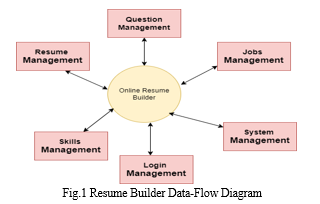
In today's competitive job market, resumes have become indispensable, serving as the first impression for potential employers. A well-crafted resume can significantly impact your chances of securing an interview. The goal of this resume builder is to provide users with professional-looking resumes without the stress of deciding what to include. It offers flexibility and streamlines the process of creating a tailored resume based on qualifications. Users simply fill out a form covering personal details, education, skills, and more, and the system automatically generates a structured resume.[2]
Creating a resume can be daunting for professionals across industries. This project, an online resume builder, simplifies the process using web development technologies like HTML, CSS, and JS.[3]
Matching job seekers with suitable opportunities has become increasingly complex. To address this, we introduce an advanced system integrating Natural Language Processing (NLP), Machine Learning, and Recommender Systems. This system enhances the career placement process for job seekers and employers alike.[4]
The "AI Resume Analyzer" prioritizes user security and ease of use, starting with secure registration and tailored experiences for freshers and experienced professionals. NLP techniques parse uploaded resumes to extract key information, while machine learning models accurately categorize candidates.[5]
At the core of the system lies its job recommendation engine, utilizing various filtering techniques to suggest roles aligned with a candidate's skills and experience. Its adaptability ensures relevance in a constantly evolving job market. Stringent measures are in place to protect user data, maintaining compliance with data protection laws.[6]
This innovative approach aims to improve hiring efficiency by leveraging AI and recommendation systems, facilitating smoother transitions into the workforce.[7]

The AI resume analyzer addresses the challenges inherent in traditional recruitment processes. With HR departments often overwhelmed by a large influx of job applications, thoroughly reviewing each resume becomes laborious and time-consuming. This can lead to inefficiencies, the potential oversight of qualified candidates, and the perpetuation of unconscious biases in hiring decisions.[8]
In response, an intelligent recruitment system leveraging machine learning algorithms proves invaluable. Such a system can assess candidates' resumes, including their skills, work history, and interests, and match them with job requirements and company culture. This ensures candidates are placed in roles that align with their skills and interests, fostering job satisfaction and enhancing company retention rates. Additionally, it streamlines the recruitment process by automatically filtering out irrelevant resumes and identifying the most suitable candidates for consideration.[9]
The objectives of an AI resume analyzer encompass several critical goals in talent acquisition and recruitment. These tools are designed to efficiently handle a large volume of resumes, speeding up initial screening processes and conserving valuable time and resources. Their primary aim is to align the qualifications, skills, and experiences outlined in resumes with job description prerequisites, thus identifying the most suitable candidates.[10]
II. LITERATURE REVIEW
Rinki Tyagi et al. (2020)[10] introduced an Android application aimed at generating formal format resumes. Users can select from a variety of templates and save their resumes in different formats. While the application is free and easy to use, it requires internet connectivity and is exclusive to the Android platform. Its primary benefits include time-saving features and a focus on content creation, with simple application creation and modification processes.
Bharti Kungwani et al. (2021)[11] developed the "Analytical Resume Builder," a web application offering analyzed statistics and resumes of fellow graduates. This enables users to compare their profiles, gain insights into industry trends, and stay informed about upcoming job opportunities. Particularly beneficial for recent graduates or those lacking resume expertise or time, this platform streamlines resume creation with its user-friendly interface.
Mgarbi et al. (2023)[16] designed an application centered on crafting visually appealing resumes using diverse templates and fonts. Users can also include links to their online profiles, such as LinkedIn and GitHub. While the application is user-friendly and free, it lacks advanced features like skill suggestions or personalized feedback, prioritizing content focus and time-saving attributes.
Bhatt et al. (2024)[14] emphasized the significance of leveraging new technologies, such as the internet, for knowledge management and information dissemination in education. Their project, the Online Training and Placement System, aimed to reduce manual errors, save time, and provide instant SMS notifications to students.
Vivian Lai et al. (2016)[1] highlighted the evolving landscape of job search and candidate evaluation with the increasing reliance on the Web for uploading and creating online resumes. Resumes serve as the primary source of information about candidates and the initial evaluation criterion in candidate selection.
Víctor Fresno et al. (2016)[2] discussed the importance of document representation in document clustering tasks, introducing a fuzzy term weighting approach that capitalizes on HTML structure for enhanced clustering performance.
Jaiswal et al. (2024)[15] noted the exponential growth of information on the World Wide Web and the inconvenience of current human intervention requirements for leveraging this wealth of information.
Zied Jaoua et al. (2012)[3] proposed an algorithm for robust reception of compressed HTML files over noisy mobile radio channels, assuming standard compliance of both source encoders and transmission systems.
Sharma et al. (2021)[17] emphasized the increasing popularity of mobile browsing and the challenges posed by limited memory capacity and bandwidth for rendering HTML documents on mobile browsers.
Ujjal Marjit et al. (2012)[4] suggested utilizing linked data to recover CV information, developing an online Chinese resume parser that extracted data using a rule-based statistical algorithm.
Tejaswini et al. (2022)[13] developed a comprehensive CV analysis system focusing on block analysis of CV documents using pattern matching and multi-level information identification. They aimed to convert CVs into an ontological structure for better information extraction using the WordNet calculation of similarity.
Table 1: Literature Survey
|
Title Paper |
Author |
Methodology |
Merits |
Demerits |
|
Resume Builder Application |
Rinki Tyagi et al. |
Recognize the essential features and capabilities necessary in the resume builder to meet user requirements and adhere to industry norms. |
Open Source Time saver |
Lack of customization. |
|
Resume Generation System |
Pooja Bhosale et al. |
Define the extent of the resume builder, encompassing its intended audience, applicable industries, and range of job categories it will serve. |
Registration mandatory |
Limited Flexibility. Industry specific limitations. |
|
Resume Builder |
Arnav Kumar et al. |
Create a user-friendly and intuitive interface for the resume builder, guaranteeing straightforward navigation and input options. |
Reduce maximum errors |
Dependency on technology. |
|
Resume Builder Application |
Shreekanth Marapaka et al. |
In the company module's resume selection process, we employ a Relevance Ranking Algorithm. |
Time saver Student gets notified by the SMS instantly |
Limited Personalization Option. |
|
Towards an Information Extraction system based on ontology to match resumes and jobs |
D.Celik et al. |
The objective of resume screening is to pinpoint the most qualified candidates for a role and to provide users with their resume score along with areas in need of enhancement. |
Removes bias by focusing on qualifications and skills rather than personal information. Reduces the likelihood of overlooking qualified candidates due to human error. |
Implementation and maintenance can be expensive, especially for smaller organizations. |
|
Understand Short Texts by Harvesting and Analyzing Semantic Knowledge |
Wen Hua et al. |
Resume screening is predominantly employed by large technology firms, where they handle a significant volume of resumes, assessing and categorizing them based on their relevance to the job description and overall strength. |
Data-Driven Insights: ML can provide valuable insights into hiring trends,candiate qualifications and process optimization |
Accessing and processing personal data on resumes may raise privacy and compliance issues, such as GDPR or CCPA. |
|
Architecture of efficient word processing using Hadoop MapReduc e for big Data Application s |
Bichitra Mandal |
Creating a system suitable for large-scale job fairs, where many applicants aim to match with as many job openings offered by companies as feasible. The system evaluates individual competitiveness and personality traits, providing job vacancy suggestions based on the electronic resumes submitted by applicants. |
AI analyzers can assess language proficiency,ensuring that candidates meet language requirements for a particular job, which is crucial for positions that require strong communication skills. |
The automated nature of AI analyzers can lead to a lack of the human touch in the initial screening process, potentially missing out on candidates with non-traditional backgrounds who might bring valuable skills and perspectives. |
|
Research Issues in Real-Time Database Systems |
Ozgur Uluso Y et al. |
The advancement of artificial intelligence (AI) technology is progressing swiftly and integrating into everyday activities. AI has the potential to assist individuals in various workplace settings. |
AI maintains a consistent evaluation process, reducing the risk of human error or variability in resume screening. |
AI analyzers may not adequately account for unique or evolving job requirements, industry- specific terminology, or variations in resume formatting, potentially causing qualified candidates to be overlooked. |
III. PROPOSED SYSYTEM
A. Proposed Statement
The current recruitment landscape faces inefficiencies for both candidates and employers. Traditional resume builders lack flexibility, forcing applicants into rigid formats. Additionally, screening methods employed by many large technology companies prioritize high-volume filtering at the expense of transparency. This lack of feedback leaves rejected candidates unsure of how to improve their applications, hindering their future prospects.
Our solution bridges this critical gap by offering a more comprehensive approach. Our system allows candidates to upload resumes in any format, utilizing advanced parsing technology to extract relevant skills and experience. Furthermore, with a candidate's explicit consent, we can integrate data from their social profiles (think professional online presence like LinkedIn) to create a richer picture of their qualifications. This empowers companies to identify the best-matched talent while providing valuable feedback to applicants, enabling them to refine their resumes for future opportunities.
B. Proposed Work
This revamped resume builder streamlines the job hunt for both candidates and recruiters. Users can create accounts with usernames, passwords, emails, or even Google logins. Existing users can securely access their profiles. After a welcoming introduction, users can craft resumes by filling in sections for personal bios (optional), contact details, education, work history, skills, and optional language proficiency. The platform allows for effortless downloads in DOC, PDF, and TXT formats. Excitingly, the website hints at future innovations, including a "smart and automated Resume Evaluation" system. This AI-powered feature could utilize Natural Language Processing (NLP) to analyze resumes, pinpoint relevant skills, and leverage classification techniques to match resumes against specific job postings. By implementing these features, the website could become a powerful tool for simplifying both resume creation and the screening process.
IV. METHODOLOGY
In essence, a system architecture is a blueprint. It outlines how a system will be built, how its components work together, and how it will function as a whole. An architecture description takes this blueprint a step further, providing a detailed document that allows experts to analyze and understand the system's structure and behavior.
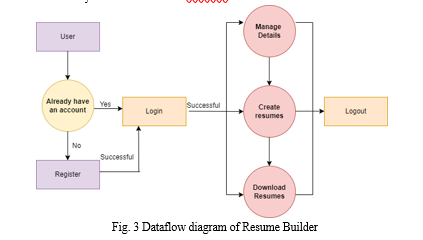
Fig.3 shows this Entity-Relationship (ER) Diagram acts as a blueprint for the core functionalities of the resume builder system. It visually maps out the relationships between various elements crucial for crafting a compelling resume. Imagine it as a roadmap guiding you through the resume creation process.
- Entities: These are the key components of the system, represented by rectangles in the diagram. They might include Users, Skills, Work Experience, Education, Resumes, and even Salary Expectations. Each entity holds specific information relevant to your resume.
- Relationships: These are the connections between the entities, depicted by lines in the diagram. For example, a User might possess various Skills, and a Resume might showcase relevant Work Experience and Education. Understanding these relationships is crucial for building a well-structured resume.
- Attributes: These are the specific details associated with each entity. Within the Skills entity, attributes might include the skill name, proficiency level, and relevant keywords. Similarly, a Work Experience entity might have attributes like company name, job title, dates of employment, and key accomplishments.
By analyzing these entities, relationships, and attributes, the ER Diagram allows us to understand how different functionalities within the resume builder work together. Imagine adding a new skill to your profile - the ER Diagram would show how this information connects to your existing skills and ultimately gets integrated into your resume. Overall, the ER Diagram provides a clear picture of how the resume builder system operates, helping you navigate its features and build an effective resume.

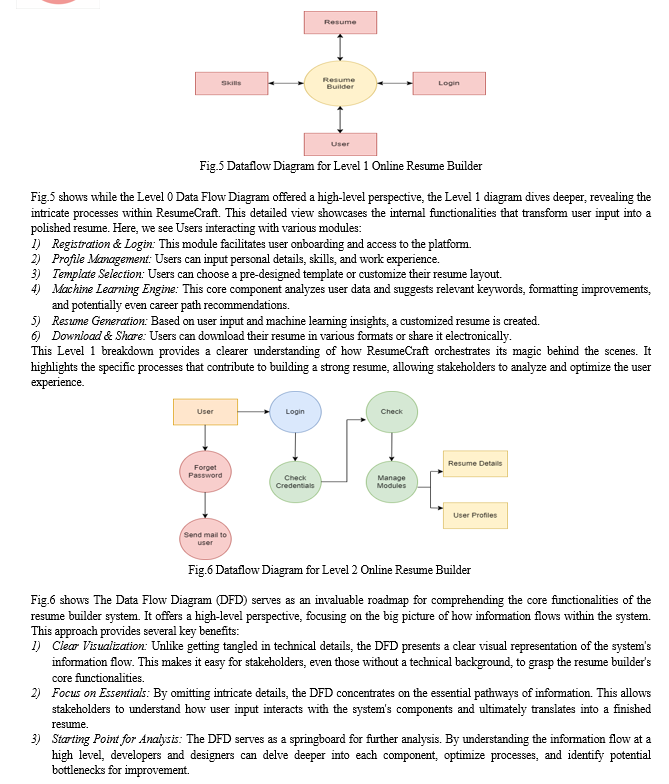
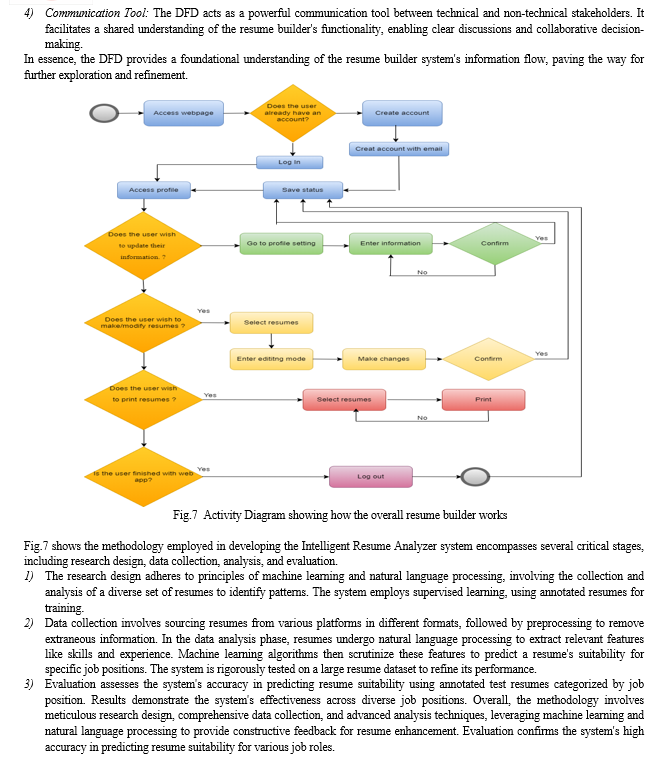
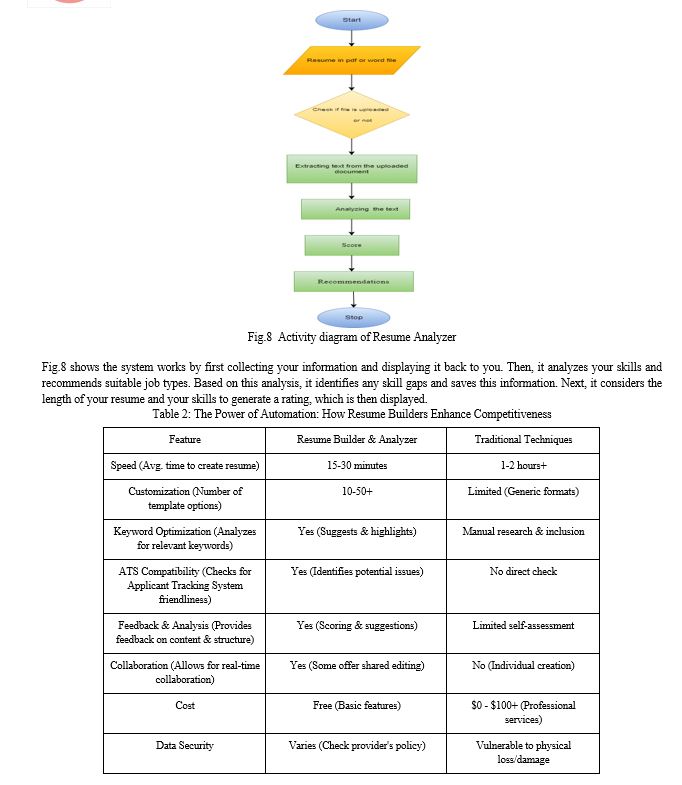
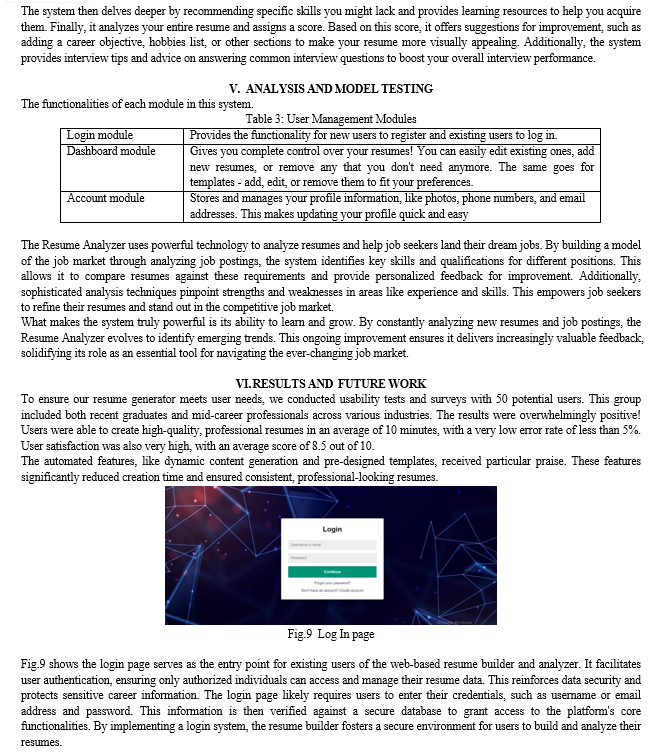
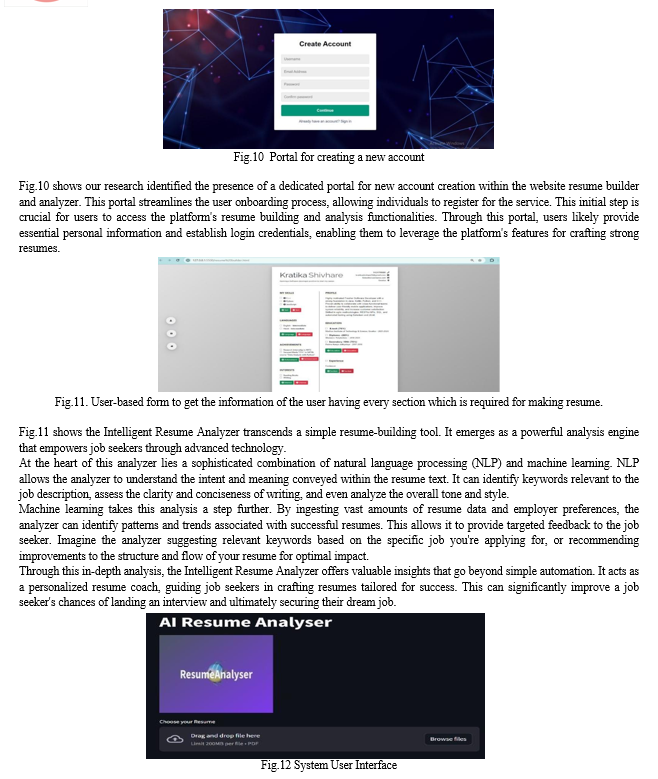
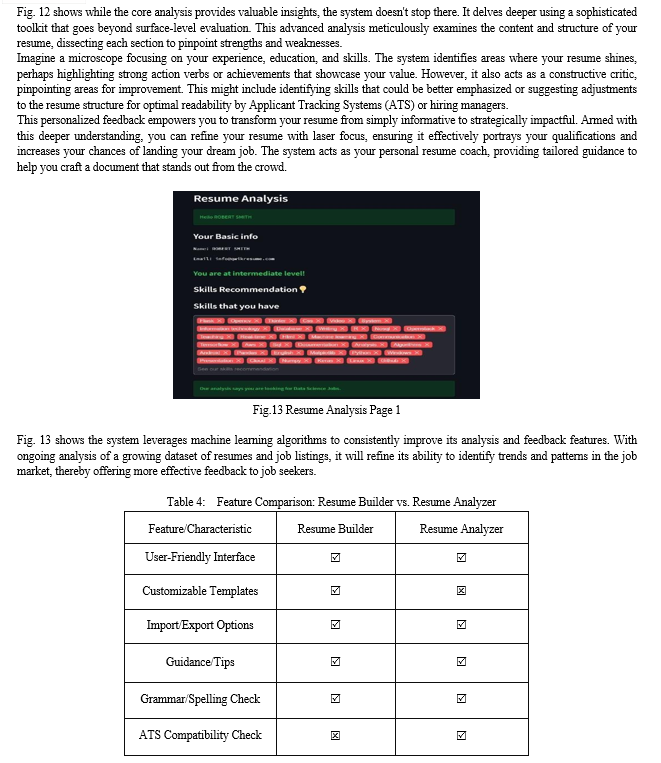

VII. ACKNOWLEDGEMENT
This project work is completed under the guidance Computer Department of Prof. Aashi Singh Bhadouria and Madhav Institute of Technology and Science, Gwalior.
Conclusion
This resume builder empowers recent graduates and resume novices. It simplifies resume creation with templates and guidance, but goes a step further. By analyzing the job market, it recommends valuable skills and courses to boost future career prospects. This benefits everyone: students get a clear career path, companies find qualified candidates, and the hiring process becomes more efficient. As technology advances, these systems will become even more powerful, handling vast amounts of data to offer even more insightful recommendations.
References
[1] Lai, V., Shim, K. J., Oentaryo, R. J., Prasetyo, P. K., Vu, C., Lim, E. P., & Lo, D. (2016, December). CareerMapper: An automated resume evaluation tool. In 2016 IEEE International conference on big data (big data) (pp. 4005-4007). IEEE. [2] García-Plaza, A. P., Fresno, V., Unanue, R. M., & Zubiaga, A. (2016). Using fuzzy logic to leverage HTML markup for web page representation. IEEE Transactions on Fuzzy Systems, 25(4), 919-933. [3] Jaoua, Z., Mokraoui, A., & Duhamel, P. (2012). Robust transmission of compressed HTML files over wireless channel using an iterative joint source-channel decoding receiver. IEEE transactions on communications, 60(9), 2679-2688. [4] Marjit, U., Sharma, K., & Biswas, U. (2012). Discovering resume information using linked data. International Journal of Web & Semantic Technology, 3(2), 51. [5] Javed, F., Luo, Q., McNair, M., Jacob, F., Zhao, M., & Kang, T. S. (2015, March). Carotene: A job title classification system for the online recruitment domain. In 2015 IEEE First International Conference on Big Data Computing Service and Applications (pp. 286-293). IEEE. [6] Jadhav, A. M., & Gadekar, D. P. (2014). A survey on text mining and its techniques. International Journal of Science and Research (IJSR), 3(11), 2110-2113. [7] Jianqiang, Z., & Xiaolin, G. (2017). Comparison research on text pre-processing methods on twitter sentiment analysis. IEEE access, 5, 2870-2879. [8] Mandal, B., Sethi, S., & Sahoo, R. K. (2015, December). Architecture of efficient word processing using Hadoop MapReduce for big data applications. In 2015 International Conference on Man and Machine Interfacing (MAMI) (pp. 1-6). IEEE. [9] Tyagi, R., Singh, N., Baghel, A., & Singh, A. (2020). Resume Builder Application. International Journal for Research in Applied Science and Engineering Technology (IJRASET) Volume, 8. [10] Kungwani, B., Manglani, A., Dembal, N., Hirani, H., & Sawlani, L. (2020). Analytical Resume Builder–A web Application for creating a resume which gives a best impact in this competitive world. Annals of the Romanian Society for Cell Biology, 235-238. [11] Chen, C. C., Huang, Y. M., & Lee, M. I. (2011). Test of a model linking applicant résumé information and hiring recommendations. International Journal of Selection and Assessment, 19(4), 374-387. [12] Tejaswini, K., Umadevi, V., Kadiwal, S. M., & Revanna, S. (2022). Design and development of machine learning based resume ranking system. Global Transitions Proceedings, 3(2), 371-375. [13] Bhatt, A., Uniyal, A., Jyala, D., Mittal, S., Tiwari, P., & Singh, D. (2024, March). Resume Analyzer based on MapReduce and Machine Learning. In 2024 IEEE International Conference on Interdisciplinary Approaches in Technology and Management for Social Innovation (IATMSI) (Vol. 2, pp. 1-5). IEEE. [14] Jaiswal, G., Uttam, A., Dubey, D. D., & Mall, P. K. (2024, March). Resume Analyser and Job RecommendationSystem Based on NLP. In 2024 2nd International Conference on Disruptive Technologies (ICDT) (pp. 1584-1587). IEEE. [15] Mgarbi, H., Chkouri, M. Y., & Tahiri, A. (2023). Towards a New Job Offers Recommendation System Based on the Candidate Resume. International Journal of Computing and Digital Systems, 14(1). [16] Sharma, A., Singhal, S., & Ajudia, D. (2021, September). Intelligent Recruitment System Using NLP. In 2021 International Conference on Artificial Intelligence and Machine Vision (AIMV) (pp. 1-5). IEEE.
Copyright
Copyright © 2024 Kratika Shivhare, Sonam Shakya, Aashi Singh Bhadouria. This is an open access article distributed under the Creative Commons Attribution License, which permits unrestricted use, distribution, and reproduction in any medium, provided the original work is properly cited.

Download Paper
Paper Id : IJRASET61731
Publish Date : 2024-05-07
ISSN : 2321-9653
Publisher Name : IJRASET
DOI Link : Click Here
 Submit Paper Online
Submit Paper Online

